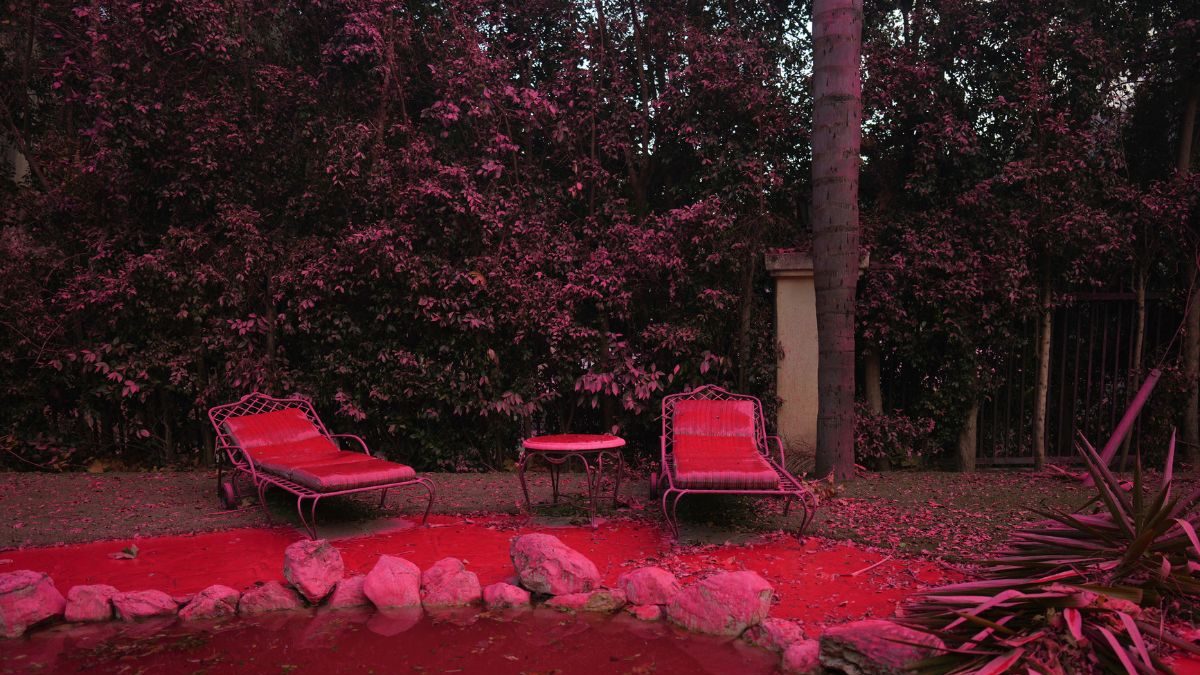Last Updated:January 13, 2025, 12:05 IST
Phos-Chek retardants are being dropped by planes around Los Angeles to limit the devastation from wildfires. Retardant use has released 850,000 pounds of toxic chemicals into the environment since 2009
Fire retardant covers a backyard in Mandeville Canyon during the Palisades Fire, on January 11, 2025, in Los Angeles. (AP Photo)
Pink retardants are being used to contain the Los Angeles wildfires, with thousands of gallons of red flame being dropped around the city in an attempt to limit the devastation.
According to a report by The New York Times, nine large retardant-spraying planes, and 20 water-dropping helicopters were being deployed to reduce the blaze that has been ongoing for the past one week due to gusty Santa Ana winds and hot temperature and dryness in the forest.
More winds are forecast to continue through Tuesday and Wednesday across Los Angeles, with low humidity creating critical fire conditions, according to the National Weather Service. Red flag warnings have been issued through Wednesday.
What Are Pink Retardants And Their Use?
The retardants are called Phos-Chek LC95, which his sold by a company called Perimeter Solutions, Daniel McCurry, associate professor in civil and environment engineering at the University of Southern California, told NPR.
Air tankers and chemical fire retardants have been used since the 1950s. The US Forest Service use them to “slow the rate of spread by cooling and coating fuels, depleting the fire of oxygen, and slowing the rate of fuel combustion as the retardant’s inorganic salts change how fuels burn.”
There are different types of fire retardants, but Phos-Chek is the most common in the United States. It is a mix of water, fertilizer, and then the red colour is just rust. The fertilizer used in explosives is called ammonium nitrate. Phos-Chek commonly contains two types of salt: diammonium phosphate ([NH4]2HPO4) and ammonium polyphosphate ((NH4PO3)n). Along with the fertilizer, ammonium phosphate, used in crystal-making kits, is also being used in Phos-Chek.
Stanton Florea, a spokesman for the National Interagency Fire Center in Boise, Idaho, told The New York Times that the retardant is sprayed ahead of the fire in a bid to coat vegetation and prevent oxygen from allowing it to burn.
How Does Phos-Chek Stop Fires From Spreading?
According to a report by NPR, cellulose in plant matter decomposes in normal circumstances as it’s heated, producing flammable compounds. Phos-Chek’s maker said the reaction between the retardant and cellulose consumes heat energy from the approaching fire and produces non-flammable carbon material. The main objective of the Phos-Chek is to minimize the fire, especially if the area includes homes or other structures.
Professor McCurry said the retardants are not dropped directly in the centre of an ongoing fire, but at at the barrier to prevent it from spreading. And even if the water evaporates, the fertilizer in the Phos-Chek keeps “that red stripe there for days or weeks,” explained McCurry to NPR.
How Much Damage Does It Cause To The Environment?
The National Forest Service banned aerial retardant in sensitive areas such as waterways and endangered species habitats. That ban is in effect “except when human life or public safety are threatened.” Using retardants in restricted areas must be reported for possible remediation.
A 2024 study by researchers at the University of Southern California (USC) found that Phos-Chek “is laden with toxic metals, and estimates retardant use has released 850,000 pounds of these chemicals into the environment since 2009,” according to a report by the Los Angeles Times. These toxic metals include chromium and cadmium which can cause cancer, and kidney and liver diseases in humans.
However, Phos-Chek does not include any substances flagged by California’s Proposition 65 list of materials that are carcinogen, that is, causing cancer, and other harms, according to its manufacturer.
Forest Service experts have found that the effectiveness of retardants is dependent on slope, fuel type, terrain and weather. Timothy Ingalsbee, a former wildland firefighter and executive director of the nonprofit Firefighters United for Safety, Ethics and Ecology, told the LA Times, “Aerial retardant is effective over a narrow range of conditions, and the windows of opportunity for those conditions are narrowing each year due to climate change.”
The New York Times reported that more than 440 million gallons of retardant were used on federal, state, and private land between 2009 and 2021 in the US. The USC study, using this figure, estimated that between 2009 and 2021, more than 400 tonnes of heavy metals were released into the environment from fire suppression.
How Much Devastation Has Been Caused By LA Wildfires?
At least 24 people have died from the fires — 16 from the Eaton Fire and 8 from the Palisades Fire. Search and rescue efforts for missing persons related to the fires began on Saturday.
Over 40,000 acres have been destroyed in the Eaton, Palisades, Kenneth and Hurst fires, according to the California Department of Forestry and Fire Protection. Homes and businesses are among the more than 12,000 structures that have been burned. Officials expect more in the coming days.
According to the latest figures from Cal Fire, the Eaton Fire has spread to more than 14,000 acres and is 27% contained. The Palisades Fire is at 24,000 acres and 11% contained. The Kenneth Fire was fully contained after burning more than 1,000 acres, while the nearly 800 acres Hurst Fire was 89% contained, as quoted by NPR.
Nearly 24,000 people have applied for disaster assistance, and the number is expected to rise, as per Federal Emergency Management Agency.
A “do not drink” advisory has been issued for areas in northern Pasadena and in Pacific Palisades. The LA Department of Water and Power said it issued the notice because of “the potential of fire-related contaminants that may have entered the water system”.
